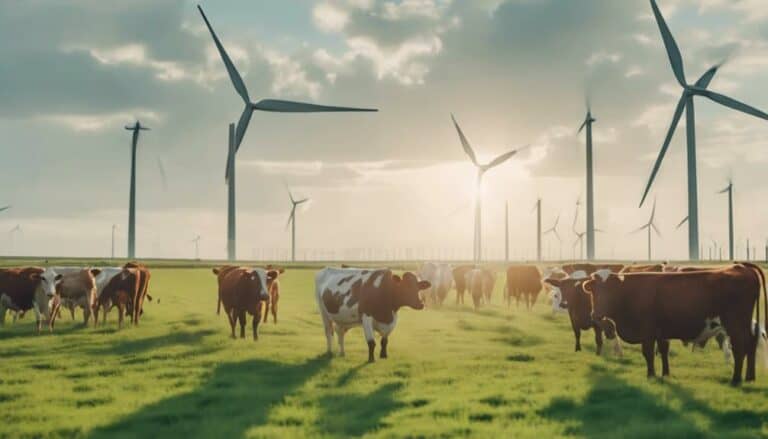Green grazing utilizes advanced technologies like IoT devices and drones to optimize livestock health and land management, promoting sustainability. Regenerative practices improve soil health and biodiversity, while holistic management techniques guarantee long-term ecosystem resilience. Monitoring tools offer real-time data for proactive veterinary care, reducing livestock losses. Sustainable land strategies restore degraded areas, enhancing water retention and carbon sequestration. Cutting-edge ranch tech, such as precision farming, minimizes environmental impact and labor. Embracing these innovations revolutionizes ranching practices for a greener, more efficient future.
Key Takeaways
- Rotational grazing enhances soil health and biodiversity.
- Holistic management prevents overgrazing and improves ecosystem resilience.
- Advanced health monitoring optimizes livestock well-being and grazing patterns.
- Sustainable land use strategies restore degraded lands and improve water retention.
- Cutting-edge technology like drones and IoT devices streamline ranch management for increased sustainability.
Regenerative Grazing Practices
Regenerative grazing practices revolutionize traditional ranching methods by implementing rotational livestock grazing on smaller pasture sections to enhance soil health and ecosystem resilience. This approach minimizes soil erosion, promotes carbon sequestration, and improves water management, all of which are important in combating climate change.
By allowing grazing rest periods, grasslands have the opportunity to regrow, increasing water retention and fostering healthier soil for enhanced carbon storage. These practices not only benefit the environment but also support biodiversity preservation and the conservation of natural resources.
Through ecological monitoring, ranchers can make sure that overgrazing is prevented, turf growth is healthier, and erosion control measures are effective. Sustainable grazing systems play a critical role in maintaining a balanced ecosystem, providing multiple benefits such as wildlife habitat improvement and offering ecological food options for communities.
Regenerative grazing practices showcase a proactive approach to ranching that prioritizes long-term ecological sustainability and resilience.
Holistic Management Techniques
Holistic management techniques in ranching encompass a thorough approach that considers the interconnectedness of the entire ecosystem, emphasizing soil health, water quality, and biodiversity conservation. By implementing holistic management practices, ranchers can promote sustainable grazing practices while enhancing wildlife habitats and improving overall ecosystem resilience.
Here are five key aspects of holistic management techniques:
- Balanced Grazing: Prevents overgrazing, soil erosion, and degradation.
- Soil Fertility: Improvements in soil health and fertility leading to increased productivity.
- Plant Diversity: Encourages a variety of plant species, supporting biodiversity.
- Ecosystem Resilience: Enhances the ecosystem's ability to withstand environmental challenges.
- Long-term Sustainability: Maintains a healthy balance for both livestock and wildlife populations.
Through these conservation practices, ranching operations can achieve sustainable land management, ensuring the long-term viability of their businesses while preserving the natural environment.
Advanced Livestock Health Monitoring
Advanced Livestock Health Monitoring technologies revolutionize the ranching industry by providing real-time data on important metrics for proactive health management and early disease detection. IoT devices like smart collars and sensors play a pivotal role in monitoring livestock health, tracking essential indicators such as body temperature and heart rate. This technology enables ranchers to take proactive measures, ensuring prompt veterinary intervention and safeguarding herd welfare. By utilizing advanced livestock health monitoring, ranchers can reduce losses in livestock, promoting overall health and well-being. Additionally, the data gathered by IoT devices facilitates the optimization of grazing patterns, preventing overgrazing and allowing for the efficient allocation of resources. Ultimately, livestock health monitoring through technology integration contributes not only to biodiversity conservation but also to the adoption of sustainable ranching practices. Check out the table below for a concise overview of the benefits of advanced livestock health monitoring.
| Benefits of Advanced Livestock Health Monitoring |
|---|
| Early disease detection |
| Proactive health management |
| Optimized grazing patterns |
| Veterinary intervention |
| Sustainable ranching practices |
Sustainable Land Use Strategies
Utilizing sustainable land use strategies in ranching involves implementing regenerative grazing practices that aim to restore degraded lands and enhance ecosystem resilience. By adopting regenerative practices, ranchers can effectively manage grazing activities to promote soil health, water conservation, and biodiversity. Key management practices include dividing pastures into smaller sections and rotating animals to mimic natural grazing patterns, minimizing soil erosion and promoting the rest and regrowth of grasses. This approach not only enhances soil fertility but also improves water retention and carbon sequestration in the soil, contributing to the fight against climate change.
- Native Plant Species: Incorporating native plants in pastures supports biodiversity and ecosystem health.
- Agroforestry: Planting trees alongside pastures provides benefits like windbreaks, erosion control, and additional income streams.
- Soil Fertility: Regenerative grazing practices improve soil health, nutrient cycling, and overall fertility.
- Water Conservation: Efficient water management and irrigation systems are essential for sustainable land use.
- Conservation Organizations: Collaborating with conservation groups can provide resources and expertise to enhance sustainable land management practices.
Cutting-Edge Ranch Technology
Cutting-edge ranch technology revolutionizes traditional practices through the integration of innovative tools and data-driven solutions to enhance operational efficiency and sustainability in modern livestock management.
Drones play an essential role in ranching by conducting detailed aerial surveys that aid in efficient land management and hazard identification.
IoT devices, such as smart collars, provide real-time monitoring of livestock health, allowing for proactive management and tracking of important metrics.
Data analytics are utilized to optimize grazing patterns and resource allocation, facilitating land regeneration and biodiversity conservation.
The integration of technology not only enhances operational efficiency but also reduces environmental impact and minimizes manual labor in ranching operations.
Additionally, precision farming techniques are instrumental in maximizing efficiency and sustainability, contributing to a more sustainable agricultural ecosystem.
Conclusion
To sum up, green grazing practices are revolutionizing the ranching industry by promoting sustainability and enhancing productivity.
Did you know that regenerative grazing practices have been shown to increase soil organic matter by up to 30% in just a few years?
By adopting holistic management techniques and utilizing advanced technologies, ranchers are able to improve livestock health, optimize land use, and contribute to a more environmentally friendly future for agriculture.
The future of ranching is indeed looking greener than ever before.

